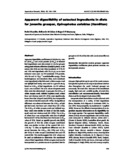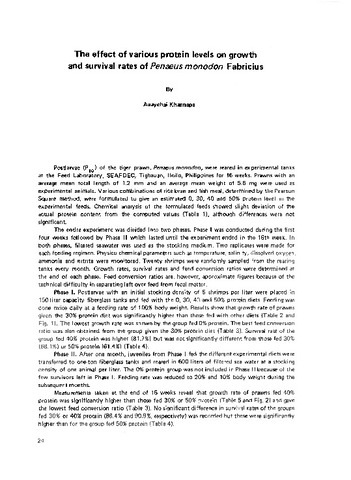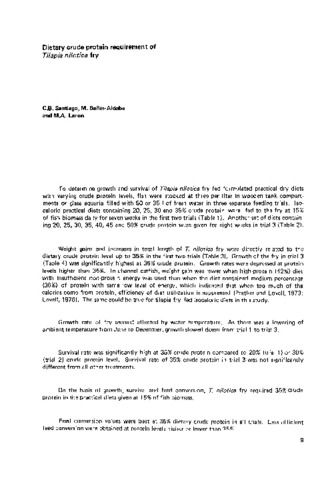Apparent digestibility of selected ingredients in diets for juvenile grouper, Epinephelus coioides (Hamilton)
- Global styles
- MLA
- Vancouver
- Elsevier - Harvard
- APA
- Help

View/Open
Date
2004Page views
7,395ASFA keyword
AGROVOC keyword
Metadata
Show full item recordCited times in Scopus
54 readers on Mendeley
- Citations
- CrossRef - Citation Indexes: 37
- Policy Citation - Policy Citations: 2
- Scopus - Citation Indexes: 52
- Captures
- Mendeley - Readers: 53
Share
Abstract
Apparent digestibility coefficients (ADCs) for dry matter (ADCdm) and crude protein (ADCcp) of selected feed ingredients were determined in vivo for grouper using passive faeces collection (Guelph System). A reference diet (RF) and test diets (consisted of 70% RF and 30% test ingredient) with 1% Cr2O3 as an inert indicator were used. An RF contained 45% protein, 10% fat and 15.7 kJ g−1 metabolizable energy. Three isonitrogenous and isocaloric diets, each contained a test ingredient (white fish meal, white cowpea meal and ipil-ipil leaf meal), were used in a growth study based on ADCcp of feed ingredients. An RF without Cr2O3 was a control. The ADC values of experimental diets were also determined. In grouper, the ADCdm of white cowpea meal, defatted soybean meal, wheat flour and shrimp meal (74–76%) were significantly lower than that of squid meal (99%), but comparable with those of the fish meals (84–89%). No significant difference was observed between the ADCdm of ipil-ipil leaf meal, rice bran and wheat flour (56–73%). The ADCcp of white cowpea meal and defatted soybean meal were similar to those of the fish meals, squid meal and shrimp meal (94–99%). The ADCcp of wheat flour was comparable with that of ipil-ipil leaf meal (79–83%). Rice bran had the lowest ADCcp value of 43%. Based on specific growth rate (SGR), the growth of fish fed white cowpea meal-based diets was similar to that of the control fish (3.2–3.3% day−1). Also, no significant difference was observed between the ADCdm (68–72%) and ADCcp (88–91%) of white cowpea meal-based diet and the control diet. The results suggest that ADC values can be used as indicators to determine the nutritional value of feed ingredients. White cowpea meal can be incorporated as a protein source in practical diet for grouper at 20.5% of the diet with no adverse effect on growth.
Suggested Citation
Eusebio, P. S., Coloso, R. M., & Mamauag, R. E. P. (2004). Apparent digestibility of selected ingredients in diets for juvenile grouper, Epinephelus coioides (Hamilton). Aquaculture Research , 35(13), 1261-1269. https://doi.org/10.1111/j.1365-2109.2004.01148.x
Type
ArticleISSN
1355-557X; 1365-2109Collections
- Journal Articles [1249]
Related items
Showing items related by title, author, creator and subject.
-
Evaluation of fish protein concentrate and lactic yeast as protein sources for shrimp feeds
Millamena, O.M.; Triño, A.V. (Asian Fisheries Society, 1994)Protein sources, hydrolyzed fish protein concentrate and plasmolyzed lactic yeast, were used to partially replace fish meal and soybean meal, respectively, in a basal diet (diet 1) at these levels; 5% fish protein concentrate ... -
The effect of various protein levels on the growth and survival rates of Penaeus monodon Fabricius
Khannapa, Auaychai (Aquaculture Department, Southeast Asian Fisheries Development Center, 1977)Postlarvae of tiger prawns, P. monodon , were fed with various protein levels of 0; 30; 40 and 50%, fish meal and rice bran were combined and pelletized for 16 wks. Prawns used had an average mean length of 1.2 mm and an ... -
Dietary crude protein requirement of Tilapia nilotica fry
Santiago, Corazon B.; Bañes-Aldaba, M.; Laron, M. A. (Aquaculture Department, Southeast Asian Fisheries Development Center, 1981)To determine growth and survival of Tilapia nilotica fry fed formulated practical dry diets with varying crude protein levels, fish were subjected to 3 seperate feeding trials. Isocaloric practical diets containing 20, 25, ...





